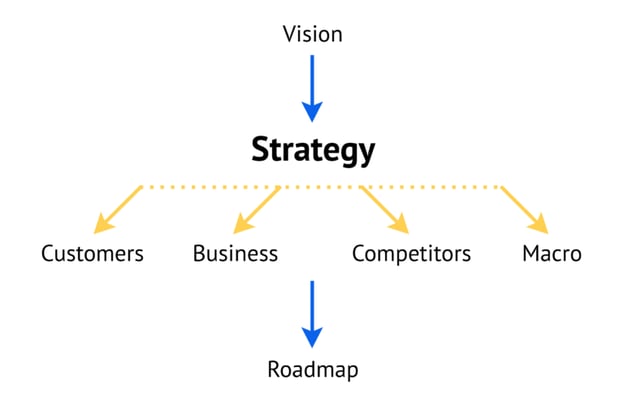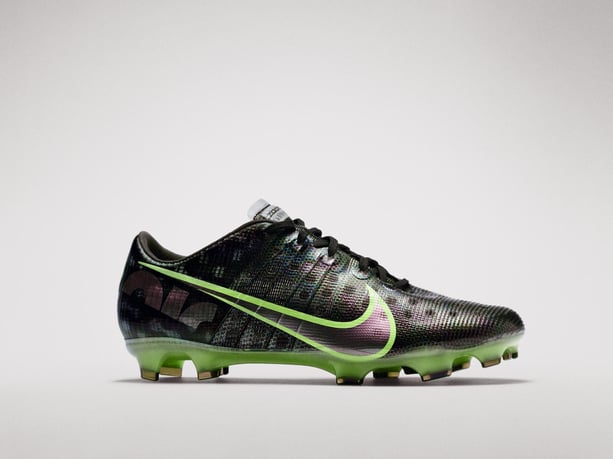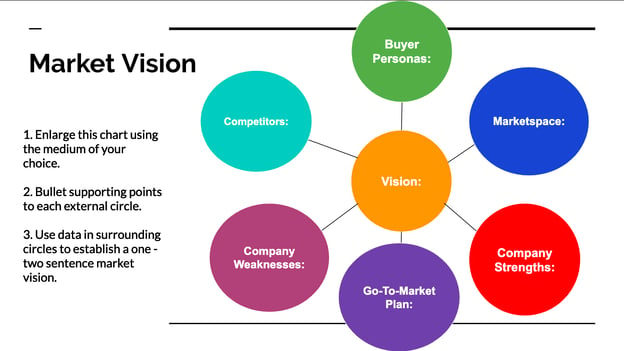Did you know that the potato chip was invented by thinly slicing French fries? Or, that Play-Doh was designed to be a cleaning product until children started using it for fun?
It’s true. These products were lucky to become the household items they are today.
However, not every successful product has to be an accident. Instead, you can ensure a product’s success by creating a strong strategy to guide its development.
In this post, we’ll discuss what product strategy is, different types of strategy, some real world examples, then provide you with a template so you can create one for your next product or feature.
What Is Product Strategy?
Your product strategy is the roadmap that’s used to develop your product or feature. It includes all of the tasks that your team needs to complete to achieve your business goals. Your team will use this document as its guide and will refer to it whenever they have questions. In fact, 70% of businesses refer to the product strategy whenever they’re making major decisions. So, it’s important to create a detailed and thorough strategy to ensure every task is completed correctly and on time.
The product strategy outlines how the product will benefit the business. It describes the problem that the product will solve and the impact that it will make on customers and the company. Once this strategy is clear, it can be used to create the product definition which explains what you will build and when. The product strategy then acts as a baseline that you’ll measure success to before, during, and after production.
The graph below outlines how this relationship plays out.

A product strategy consists of three major components. Let’s review each one in the sections below.
Market Vision
The market vision describes who will be using your product and what that opportunity means for the business. It highlights your target customers, how you’ll position your product, and how it’ll fare against other competitors in its space. Your market vision should also include a go-to-market plan that explains your customers’ needs and how you’ll deliver a competitive offer.
Product Goals
You can’t create a product strategy without key objectives. These are specific goals or metrics that you’ll achieve as a result of building your product. They guide your development team and help you measure success once the product is released.
When goal-setting, it’s important to make your objectives time-based, so there’s urgency for when you’ll accomplish them. This adds more importance to your product’s development because you’ve added a time-constraint to its success.
Product Initiatives
Product initiatives are similar to product goals, but they’re more conceptual. These are big-picture ideas or trends that you’ll influence as a result of your new product.
For example, when HubSpot launched its CRM, it didn’t want to just sell software. It wanted to become a thought-leader in marketing automation and reveal new business opportunities for its users. That bigger picture of the product’s impact helped establish a clear vision for how HubSpot would create and develop its tools over time.
Now that we’ve dissected the anatomy of product strategy, you should be familiar with the core components that go into designing a product. However, how you organize this information can vary depending on the product you’re creating or the expectations laid out by management.
Below, let’s take a look at some of the different product strategies you can use at your business.
Types of Product Strategies
1. Cost Strategy
A cost strategy focuses on creating the best product for the lowest price. It assesses the resources being used and determines where money can be saved during production.
This is a useful strategy for low-effort purchases like household cleaning items. These are things that most of us don’t think too much about when buying because all of the products in this space are essentially the same and we typically don’t have any loyalty towards a particular brand. So for these industries, if you can create a product that undercuts your competitors’ price point, it’ll be a sure favorite for your customer base.
2. Differentiation Strategy
Price isn’t the end-all-be-all when it comes to differentiating your product. There are plenty of other ways that you can make it stand out in your industry. Maybe it’s a luxury product that uses the best materials. Or, maybe it has ground-breaking features that revolutionize the space altogether. Whichever it may be, this approach focuses on giving your product a personality that makes it memorable and delightful to your customers.
3. Focus Strategy
If your company has a large customer base, maybe you want to create a product that appeals to one specific buyer persona. This is an effective strategy because it targets the needs of a select group of people and creates a personalized solution for them. This is a great way to gain brand loyalty when acquiring new customers.
4. Quality Strategy
Sometimes what can set your item apart from competitors could be the make and brand behind it. Quality strategy focuses on the customers who are looking for the highest quality product in the market. The prices are naturally high to compensate for the supplies needed in production, but that does not deter some buyers. If it is recognized as a luxury, a number of customers will go out of their way to pay for it if they believe it’s worth the investment.
5. Service Strategy
Many customers may be looking for a certain product, but will base their purchasing decision on the customer service provided by the company selling it. Companies that use outstanding service offerings to attract customers understand just how valuable that reputation can be. By providing quick response and better after-sales service, brand loyalty in any market can be built to last.
Product Strategy Examples
Now that we’ve covered the five main approaches to product strategy, let’s see these put into action with real-world examples.
Telfar
Telfar is a black owned luxury brand that began selling bags in 2014 by fashion designer Telfar Clemens. Telfar quickly gained popularity in 2020 for its intimate, unapologetic, and out-there brand image that celebrates people of all backgrounds. This was made possible with Telfar’s well-thought-out product strategy. The company defied expectations and created a product and marketing campaign that successfully resonated with its customer base.
Let’s take a look at the strategy Telfar created to ensure the success of the Signature Telfar Shopping Bag.
Telfar Market Vision
When defining the market vision, Telfar focused their efforts on making a bag “Not For You — For Everyone”. They wanted to create a bag that was sleek in design and innovative for its glamourization of average everyday people, as opposed to other luxury brands that highlight their product with celebrity endorsements. Clemens identified their target market to be a wide range of people looking for an affordable luxury accessory.
Telfar Product Goal
Once the vision and market fit was discovered, Clemens established goals for getting their product to everyone. Their main goals were to sell bags that look good on everyone and ensure everyone who wanted a bag, got one.
When the Telfar brand grew, customers became unable to attain the products due to high demand and bots taking most of their inventory every new product release. Telfar then came up with an innovative strategy to overcome this nuisance with their Bag Security Program. When new bags were released, customers could order the exact bag model and color of their choosing, and have it shipped in a specified time window. This was a different form of product development as mainstream brands would make limited products until they sold out. Telfar both meets their goal and provides a unique service to give customers their desired product without the fear of scarcity.

Telfar Product Initiatives
Telfar’s bags did not rise in popularity from their vision and product goals alone, but with a marketing team that positioned themselves as the next big thing in fashion.
Telfar’s marketing team understood the importance of inclusiveness and affordability from their early beginnings, and their message resonated with the public and their call for equity and fairness last year. Not only that, but they took to the most popular social media channels like TikTok and Instagram to showcase unique individuals and crazy campaign advertisements with skydivers and freestyle dancers to convey the energy of the brand. They turned your average sales pitch into a celebration of individuality and better communicated what made Telfar different from their competitors.

Nike
Nike has been known for its innovative products since the first shoe it released in 1971. Recently, the company has taken more experimental approaches when releasing a new shoe concept, the Nike Air Zoom Mercurial. A unique football cleat that combined computational design with air bag technology.
While the model is strikingly different from the company’s other cleats, Nike created a product and marketing campaign that surprisingly resonated with its customer base.
Let’s take a look at the strategy Nike created to ensure the success of the Nike Air Zoom Mercurial.
Nike Market Vision
When defining the market vision, Nike focused its research in 3D-printed Flyprint textiles and automobile safety features. They wanted to create a shoe that was innovative but seemed familiar to the user. So, the research team tested the efficiency of the Air Zoom Mercurial on actual football players.
This led them to see air bag technology for its unique underfoot sensation and energy return, creating a shoe like no other. While it went against Nike’s conventional vision, this was exactly the type of innovation that the product team needed to develop a ground-breaking product.
Nike Product Goal
Nike’s vision for the Air Zoom was established, and they made their product goal just as clear. The Air Zoom Mercurial was going to have a differentiating factor to stand out — it needed to provide more energy return with each step.
Nike’s customers could benefit from the airbag technology because of the amount of dynamic movement that takes place in football games. Using pressure sensors on the athletes’ feet, the research team captured exactly how the foot bounces off different sections of the shoe, and how to position the internal Zoom Air bag chassis in the sole. Using this data, the product development team’s goal became creating a shoe that almost gives customers an extra boost with each step.

Nike Product Initiatives
Nike’s product initiative for this new Mercurial was a more informational approach than their other cleats. Since this release was built differently from their traditional cleat, they needed to justify that athletes would still buy the product.
Nike’s marketing team decided while the shoe would make athletes perform better, it was too risky to depend on customers to switch from the shoes they were already loyal to. Instead, they chose to educate customers about how the newfound technology could help them practice and would position the product as a training tool. That way, Nike lifted the pressure on the sales pitch and could better communicate the product’s differentiator.

Now that you see how a product strategy is formed, you may want to start on one with your team. If so, take a look at the section below for a template that can help you get started.
Product Strategy Template
1. Download the template here.
Having a visual tool to map out your product strategy helps you to organize your ideas and learn how to put them into action.
2. Create your market vision.
This second slide can help you create your market vision with our provided idea web graphic organizer. Determine where you want to position your product in the market place and figure out what you’re up against.

3. Establish product goals.
Once your vision is complete, you can use the third slide to establish your product goals. Use each column to make a definitive plan with actionable steps.

4. Make product initiatives.
Finally, once you lay out your goals, you can use a similar table to list your product initiatives. Think beyond the numbers and determine what your product is trying to accomplish in the long haul.

Forming a thorough product strategy is key to reaching your target audience. When you position it correctly, you’re setting yourself up to become a real competitor in the marketplace. This is only part of the journey, but having somewhere to start can be the difference between being a market follower, or market leader.
Editor’s note: This post was originally published in December 2019 and has been updated for comprehensiveness.

![→ Download Now: Free Product Marketing Kit [Free Templates]](https://no-cache.hubspot.com/cta/default/53/08b5e1f4-5d26-405b-b986-29c99bd0cb14.png)
